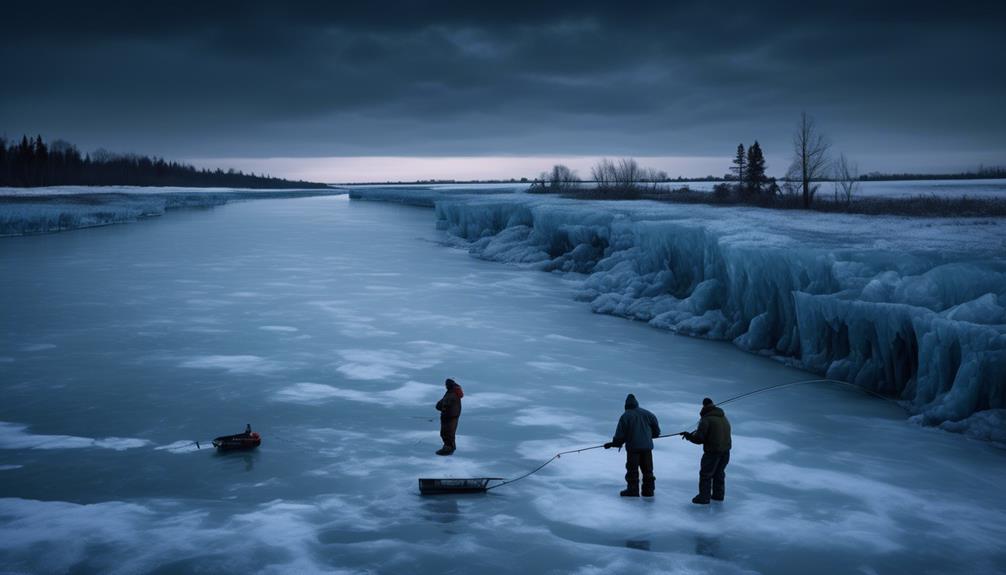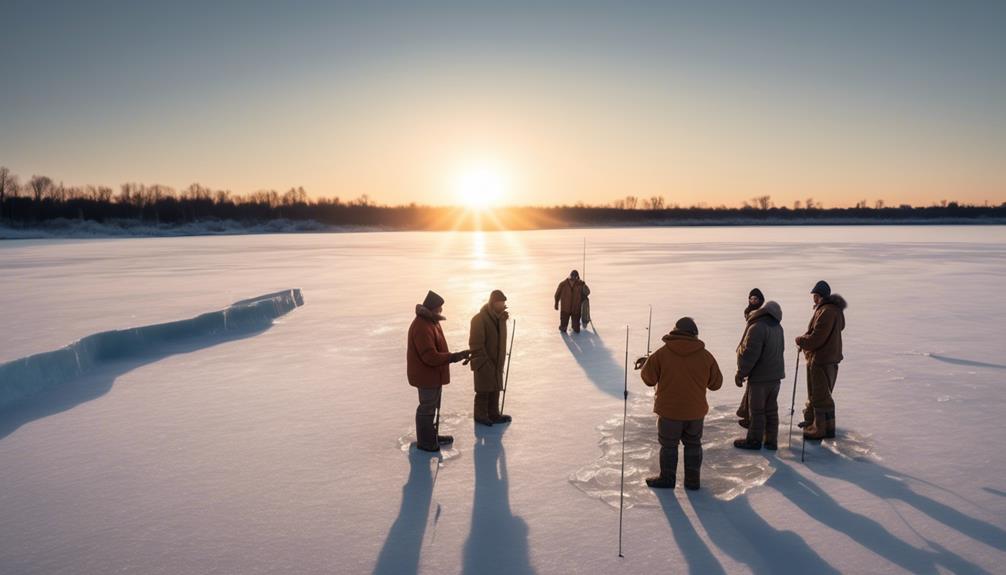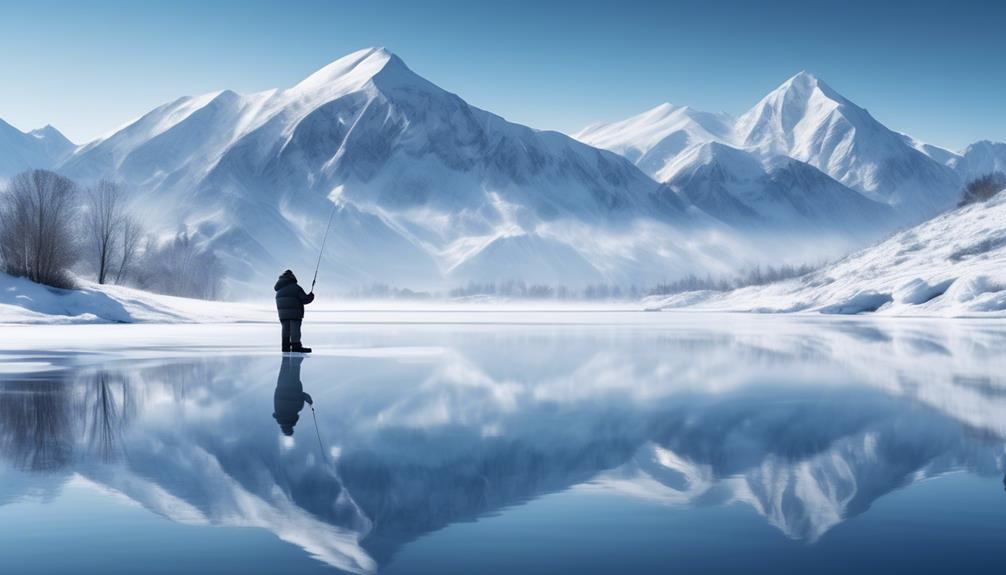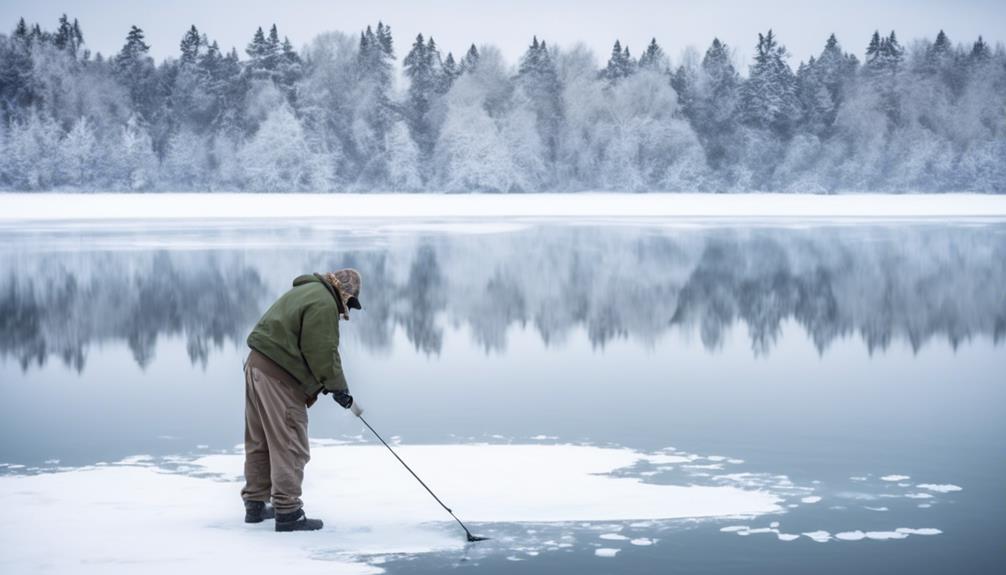Imagine standing on the edge of a frozen river, its icy surface stretching out like a blank canvas waiting to be filled with the thrill of a new adventure.
As you peer into the crystal-clear depths, you begin to understand why frozen rivers are like a hidden treasure trove for walleye ice fishing enthusiasts. The tranquility of the frozen water belies the activity teeming beneath the surface, and it's this juxtaposition that makes these rivers perfect for targeting walleye during the winter months.
But just why exactly do these frozen rivers hold such allure for walleye anglers? Well, there's a fascinating interplay of factors at play that not only make them an ideal habitat for walleye but also provide unique advantages for ice fishing.
Walleye Behavior in Frozen Rivers
As winter sets in and the rivers freeze over, walleye behavior undergoes significant changes, impacting their feeding habits and movement patterns. The transition from open water to frozen rivers profoundly affects how walleye feed and where they can be found.
When rivers freeze, walleye adjust their feeding behavior to adapt to the new ice conditions. They tend to become more lethargic and feed less frequently due to the decreased metabolism caused by the cold water. As a result, they may not actively pursue prey as they do in warmer months, but rather conserve energy and feed opportunistically. Understanding these changes in walleye feeding patterns is crucial for success when ice fishing in frozen rivers.
Moreover, the presence of river ice influences the movement patterns of walleye. As the ice cover becomes more extensive, walleye tend to concentrate in areas with slower currents and deeper water. The ice acts as a barrier, restricting their movement and confining them to specific areas within the river. In addition, walleye often seek out areas where the ice meets the riverbed, creating natural openings that allow them to access prey and conserve energy by minimizing their movements.
Advantages of Ice Fishing in Rivers
Ice fishing in rivers during the winter months offers unique advantages for anglers seeking walleye. When it comes to river ice fishing techniques, one major advantage is the flow of the water. Unlike lakes, rivers have constant movement beneath the ice, which can attract walleye looking for food. This means that you can strategically position yourself to take advantage of this flow, increasing your chances of a successful catch. Additionally, the natural current can help disperse scent and attract fish to your location more effectively than on still waters.
Moreover, river ice fishing presents anglers with a variety of challenges that ultimately enhance the experience. Navigating the currents and eddies of a river demands a different skill set compared to fishing on a static lake surface. This challenge adds an element of excitement and skill refinement to your ice fishing endeavors. Furthermore, the diverse structure of riverbeds offers opportunities for exploration and experimentation. The varying depths, channels, and underwater features in rivers can lead to discovering new, productive fishing spots.
Best Time to Ice Fish for Walleye
Navigating the currents and eddies of a river demands a different skill set compared to fishing on a static lake surface, and understanding the best time to ice fish for walleye is crucial for maximizing your chances of a successful catch.
When it comes to targeting walleye through the ice, monitoring ice thickness is paramount for safety. Typically, a minimum of 4 inches of clear, hard ice is recommended for ice fishing, but for larger groups or vehicles, 8-12 inches is necessary. However, it's important to note that ice thickness can vary across the same body of water due to factors such as currents, springs, and temperature fluctuations.
In addition to ice thickness, weather conditions play a crucial role in determining the best time to ice fish for walleye. Walleye tend to be more active during low-light conditions such as dawn, dusk, and overcast days. Therefore, planning your ice fishing excursion during these times can significantly increase your chances of a successful catch. Moreover, monitoring barometric pressure changes can also be beneficial, as walleye are known to be more active before a front moves in.
Understanding River Currents and Walleye
When fishing for walleye in a river, understanding the patterns and dynamics of the current is essential for optimizing your chances of a successful catch. The river ecosystem plays a crucial role in the behavior and movement of walleye, making it imperative to comprehend how river currents impact their feeding habits. As a walleye angler, having a grasp of these dynamics will greatly enhance your fishing techniques and overall success.
River currents influence the distribution and movement of walleye within the river. These currents create areas of slack water, eddies, and current breaks where walleye tend to congregate. By understanding the flow patterns, you can identify these prime fishing spots.
When the current encounters obstacles such as boulders, fallen trees, or changes in river depth, it creates eddies and slack water areas that serve as natural feeding grounds for walleye. These spots provide an opportunity for walleye to conserve energy while waiting for prey to be carried by the current, making them ideal locations for anglers.
Furthermore, comprehending river currents is essential for presenting your bait effectively. Fishing techniques such as drift fishing and bottom bouncing rely heavily on understanding the speed and direction of the current. By adjusting your presentation to match the flow of the river, you can significantly increase your chances of enticing a strike from walleye.
Therefore, mastering the relationship between river currents and walleye behavior is fundamental for a successful fishing expedition.
Key Equipment for River Ice Fishing
Understanding river currents is crucial for optimizing your walleye ice fishing equipment, ensuring you have the right gear to capitalize on the dynamics of the frozen river. When it comes to river ice conditions, having the appropriate ice fishing gear is essential for a successful and safe fishing experience.
- Ice Auger: A reliable ice auger is indispensable for drilling through thick ice and accessing the walleye-rich waters below. Look for an auger with sharp blades and a powerful motor to swiftly bore through the frozen surface.
- Portable Shelter: In the unpredictable and often harsh conditions of frozen rivers, a portable ice fishing shelter provides much-needed protection from the elements. A well-insulated shelter not only keeps you warm but also shields you from biting winds, ensuring your comfort and safety while fishing.
- Underwater Camera: As river currents can influence the behavior and location of walleye, an underwater camera becomes a valuable tool for scouting potential fishing spots. By gaining visual insight into the underwater environment, you can strategically position yourself for a higher chance of success.
Having the right equipment for river ice fishing is crucial for adapting to the ever-changing conditions and maximizing your chances of landing a prized walleye. Therefore, it's imperative to invest in high-quality gear that can withstand the challenges posed by frozen river environments.
Safety Tips for Ice Fishing in Rivers
For safe ice fishing on rivers, it's essential to prioritize preparation and awareness of the unique hazards posed by frozen waterways. When venturing onto river ice, always check the ice thickness. River ice can be deceiving due to varying currents and depths, so a minimum thickness of 4 inches is generally recommended for safety. However, it's crucial to remember that ice thickness can vary even within the same body of water. Be sure to use an ice auger to test the thickness as you move further onto the river.
Additionally, always keep safety precautions in mind. This includes wearing a flotation device, such as a life jacket, and carrying ice picks in case of an emergency.
Furthermore, familiarize yourself with river ice fishing regulations and legal requirements in your area. Different locations may have specific rules governing ice fishing on rivers, including permissible locations, catch limits, and required permits. Adhering to these regulations not only ensures compliance with the law but also contributes to the conservation of fish populations and the preservation of the natural environment.
Lastly, never venture onto river ice alone. Always bring a buddy and inform others about your plans, including your expected return time. In the event of an emergency, having someone aware of your whereabouts can be crucial. By prioritizing safety, preparation, and adherence to regulations, you can enjoy the thrills of ice fishing on rivers while minimizing potential risks.
Locating Walleye Hotspots in Frozen Rivers

Before you start seeking out walleye hotspots in frozen rivers, always ensure that you have checked the ice thickness and are equipped with the necessary safety gear. Once safety is assured, locating walleye hotspots in frozen rivers can be an exhilarating experience. Here are some tips to help you find the best spots to catch walleye:
- Look for confluences: Walleye often gather at the confluence of rivers or streams, especially in frozen conditions. The mixing of currents and the presence of food sources make these areas ideal for walleye fishing.
- Target deep pools: In frozen rivers, walleye tend to seek out deep pools where they can find refuge from the cold and access to prey. These deep areas provide a prime location for targeting walleye during ice fishing.
- Follow the current breaks: Where the current slows down or changes direction, walleye are likely to be found. Look for areas where the current breaks, such as behind boulders or along the edges of ice shelves. These spots are often frequented by walleye seeking shelter and an easy meal.
When finding walleye in frozen rivers, it's essential to adapt traditional river ice fishing locations and strategies to the unique conditions of frozen waterways. By understanding the behavior of walleye in frozen rivers and employing the right techniques, you can increase your chances of a successful ice fishing expedition.
Techniques for Successful River Ice Fishing
To maximize your success in river ice fishing for walleye, employing effective techniques is crucial for increasing your catch. When ice fishing on rivers, it's essential to adapt your approach to the unique conditions.
Firstly, drilling multiple holes is key for exploring different depths and finding active fish. Start shallow and gradually move deeper until you locate the walleye. Using a depth finder can also help identify underwater structures and potential hotspots.
Once you've found a promising area, employing vertical jigging is a proven technique for enticing walleye. This involves using a jigging spoon or minnow-tipped jig to bounce off the riverbed, mimicking the movements of prey. Vary your jigging motion and pay attention to any subtle bites or tugs.
Additionally, setting up tip-ups with live bait like shiners or suckers can cover more water and increase your chances of a catch. Strategically positioning them in areas with current breaks or near drop-offs can yield great results. It's crucial to remain patient and observant, as walleye can be selective feeders.
Lastly, staying mobile and being willing to relocate if the bite is slow is a valuable tactic. By employing these ice fishing techniques and river fishing tips, you can enhance your chances of a successful walleye ice fishing excursion.
Frequently Asked Questions
Can Walleye Be Caught in Frozen Rivers Year-Round, or Are There Specific Seasons for Ice Fishing?
You can catch walleye in frozen rivers year-round, but there are specific seasons for ice fishing. Optimal conditions for year-round fishing depend on the location and seasonal patterns. Frozen rivers are great for ice fishing during winter.
How Does the Thickness of the Ice in a Frozen River Affect the Behavior and Movement of Walleye?
When ice on a river thickens, it affects walleye behavior and movement. Thicker ice can limit their movement and change their feeding habits. Consider environmental factors and use effective baits to avoid common mistakes when ice fishing for walleye in frozen rivers.
Are There Any Specific Baits or Lures That Are More Effective for Ice Fishing for Walleye in Rivers Compared to Other Bodies of Water?
When ice fishing for walleye in rivers, using live bait like minnows or shiners can be the best bait. Jigging with spoons or vertical jigging with soft plastics are effective ice fishing techniques to lure walleye in rivers.
What Are Some Common Mistakes That Ice Fishers Make When Targeting Walleye in Frozen Rivers?
When ice fishing for walleye in frozen rivers, common mistakes include underestimating ice thickness, using the wrong bait, and not adjusting techniques for walleye behavior. Be aware of environmental impact and choose bait wisely.
How Do Environmental Factors, Such as Temperature and Weather Patterns, Impact the Behavior and Feeding Habits of Walleye in Frozen Rivers?
In frozen rivers, temperature and weather patterns significantly impact walleye behavior and feeding habits. Warmer temperatures may increase activity, while changes in weather can affect their movement and feeding locations.
Conclusion
So, next time you're looking for the perfect spot to catch some walleye, consider heading to a frozen river.
With the right equipment, understanding of walleye behavior, and knowledge of river currents, you'll have a great chance of reeling in some big ones.
Just remember to stay safe and use the proper techniques for successful river ice fishing.
Happy fishing!



